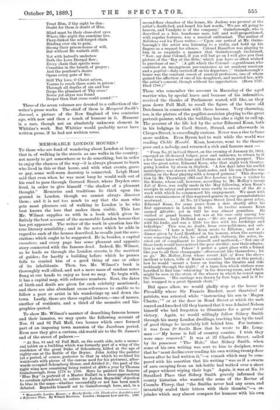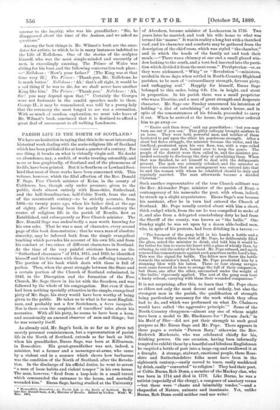MEMORABLE LONDON HOUSES.* To those who are fond of wandering
about London at large— that is, of walking in the streets as one walks in the country, not merely to get somewhere or to do something, but in order to enjoy the chances of the way—it is always pleasant to learn who lived in this or that house, and with what events, grave or gay, some well-worn doorstep is connected. Leigh Hunt said that even when he was most busy he would walk out of his road to pass through Gerrard Street, where Dryden once lived, in order to give himself " the shadow of a pleasant thought." Memories and traditions lie thick upon the ground in London, though we cannot always discover them ; and it is not too much to say that the man who gets most pleasure out of walking in London is he who best knows the lore that makes them visible. This lore Mr. Wilmot supplies us with in a book which gives in-
finitely the best account of the memorable London houses that has yet appeared. The writer of the work in question has the true literary sensibility ; and in the notes which he adds in regard to each of the houses described, he recalls just the asso- ciations which ought to be suggested. He is, besides, a capital raconteur, and every page has some pleasant and apposite
story connected with the famous dead. Indeed, Mr. Wilmot, as he leads us through the London streets, is the merriest of guides ; for hardly a building before which he pauses fails to remind him of a good thing of one or other of its inhabitants. Then, too, Mr. Wilmot's book is thoroughly well edited, and not a mere mass of random notes flung at our heads to enjoy as beat we may. To begin with, it has a capital map, with reference numbers. Next, the dates of birth and death are given for each celebrity mentioned ; and there are also abundant cross-references to enable us to follow a poet or artist in his wanderings up and down the town. Lastly, there are three capital indexes,—one of names, another of residents, and a third of the memoirs and bio- graphies quoted.
To show Mr. Wilmot's manner of describing famous houses and their inmates, we may quote the following account of Nos. 81 and 82 Pall Mall, two houses which once formed part of an imposing town mansion of the Jacobean period. Even now they give a curious, old-world air to the St. James's end of the street of palaces :—
" It Nos. 81 and 82 Pall Mall, on the south side, note a memo- rial tablet on a building which was formerly part of a wing of the residence of the great Duke of Schomberg, killed at the age of eighty-one at the Battle of the Boyne. John Astley the painter (at a period, of course, posterior to that in which he re-lined his waistcoats with pieces of the canvas used for his pictures), after wards occupied Schomberg House, and divided it ; the part of the right wing now remaining being rented at £300 a year by Thomas Gainsborough, from 1778 to 1788. Here he painted the famous 'Blue Boy' (a portrait of a Master Bullatt in a dress approaching to cerulean splendour), to refute Sir Joshua Reynolds' objection to blue in the mass—whether successfully or not has been much debated. Reynolds himself sat to Gainsborongh here, and, in a • Memorable London Houses: a Handy Guide, with Illustrative Anecdotes and a Reference Plan. By Wilmot Harrison. London: Sampson Low and CO. 1889.
second-floor chamber of the house, Sir Joshua was present at the artist's death-bed, and heard his last words, We are all going to heaven, and Vandyke is of the company.' Gainsborough, who is described as a fair, handsome man, tall and well-proportioned, with regular features, was a musical enthusiast. The author of
Nollekens and his Times writes Upon our arrival at Mr. Gains- borough's the artist was listening to a violin, and held up his fingers as a request for silence. Colonel Hamilton was playing to him in so exquisite a manner that Gainsborough exclaimed, " Now, my dear Colonel, if you will but go on I will give you that picture of the Boy at the Stile,' which you have so often wished to purchase of me." [A gift which the Colonel—a gentleman who combined an incongruous pre-eminence as an amateur musican and a pugilist—duly carried off on his departure.] ' Gainsborough's house was the constant resort of musical professors, one of whom gained the affection of one of his daughters, and married her, with the artist's consent, though without his approbation. (Born 1727. Died 1788.)"
Those who remember the account in Macaulay of the aged warrior who, by special leave and because of his infirmities, received the thanks of Parliament seated, will like, as they pass down Pall Mall, to recall the figure of the brave old Dutchman in connection with these houses. Very charming, too, is the picture of the pugilist-musician playing to the great portrait-painter, which the building has also a right to call up. The account of the life led by the actor Edmund Kean, both
in his lodgings in Cecil Street, Strand, and afterwards in Clarges Street, is exceedingly curious. Never was a rise to fame more sudden. Even Byron had to wait while the world was reading Childe Harold. Kean, however, went to the theatre poor and a nobody, and returned a rich and famous man :- "From No. 21 in Cecil Street, on the evening of January 26, 1814, emerged an ill-dressed lodger, poor and unknown, to return to it a few hours later with fame and fortune in certain prospect. This was the great actor, Edmund Kean, who that night took theatre- going London by storm in Shylock. A few days later his sordid mantelpiece was strewn with bank-notes, and his son Charles was sitting on the floor playing with a heap of guineas.' This descrip- - tion by Mr. Thornbury (Old and New London) is from a visitor to the Keane, whose call, however, according to Mr. Molloy's recent Life of Kean, was really made in the May following, when Kean's receipts in salary and presents were vastly in excess of the week with which he commenced his engagement. We meet with other reminiscences of this wayward genius in our perambulations westward At No. 12 Clarges Street lived the great actor, Edmund Kean, for some years from a date shortly after his first appearance in London in 1814. In twelve seasons Kean earned af.20,000 ; yet in 1827 he was almost penniless. Ho visited at grand houses, but was at his ease only among low companions. Lady Holland says,—' He ate most pertinaciously with his knife, and was a little too free with his lordships and ladyships.' This was, no doubt, from over-politeness, not sub- servience. I hate a lord,' Kean wrote to Elliston ; and at a dinner given by Lord Hertford in his honour, when the servants were removing the cloth, he called aside Oxberry, the actor, in- vited out of compliment to himself, and muttered,—' Not one of these lords would have noticed the poor stroller; now their admira- tion is unbounded. Pshaw ! I prefer a quiet glass with a friend like you to all their champagne—effervescent like themselves ; let us go.' Mr. Molloy, from whose recent Life of Kean the above incident is taken, tells of Kean's eccentric habits at this period ; how he would mount a horse on leaving the theatre and ride recklessly through the night ;' of a tame lion which visitors were horrified to find him educating' in his drawing-room, and which might be seen in the stern of the wherry in which he rowed upon. the Thames. His carriage was drawn by four bays, and in it he lay, wrapped in a great Spanish cloak. "
Did space allow, we would gladly stop at the house in Piccadilly where Sir Francis Burdett, most theatrical of patriots, was arrested while " instructing his son in Magna Charta ; ' " or at the door in Bond Street at which the mob roared and knocked till they learned that it was Admiral Nelson himself who had forgotten to illuminate for a great naval victory. Again, we would willingly follow Sidney Smith through his many London dwellings, tracking him by the trail of good things he invariably left behind him. For instance, it was from 20 Savile Row that he wrote to Mr. Long- man :—" My house is full of country cousins. I wish they were once removed." It was at 33 Charles Street, called by its possessor " The Hole," that Sidney Smith, when some of his own writing was sent to him to decipher, wrote that he "must decline ever reading his own writing twenty-four hours after he had written it,"—a remark which may be com- pared with his assertion that his writing " was as if a swarm of ants escaping from an ink-bottle had walked over a sheet of paper without wiping their legs." Again, it was at No. 18 Stratford Place that Sidney Smith gravely informed the county historian who wanted the arms of the Rector of Coombe Florey, that "the Smiths never had any arms, and
invariably sealed their letters with their thumbs,"—a re- joinder which may almost compare for humour with his own answer to the inquiry, who was his grandfather : " Sir, he disappeared about the time of the Assizes, and we asked no questions."
Among the best things in Mr. Wilmot's book are the anec- dotes for artists, to which he is in many instances indebted to the Life of Nollekens. One of the stories of the sculptor himself, who was the most simple-minded and uncourtly of men, is exceedingly amusing. The Prince of Wales was sitting for his bust, and the following conversation took place : —" Nollekens : How's your father ?' [The King was at that time very ill.] The Prince : Thank-you, Mr. Nollekens, he is much better.' Nollekens : Ah ! that's all right, it would be a sad thing if he was to die, for we shall never have another King like him.' The Prince : Thank-you.' Nollekens : Ah, Sir ! you may depend upon that.' " Certainly the Georges were not fortunate in the candid speeches made to them. George II., it may be remembered, was told by a young lady that the ceremony she most longed to see was a coronation. With so much of random exploration, we must take leave of Mr. Wilmot's book, convinced that it is destined to afford a great deal of amusement to all walking Londoners.







































 Previous page
Previous page